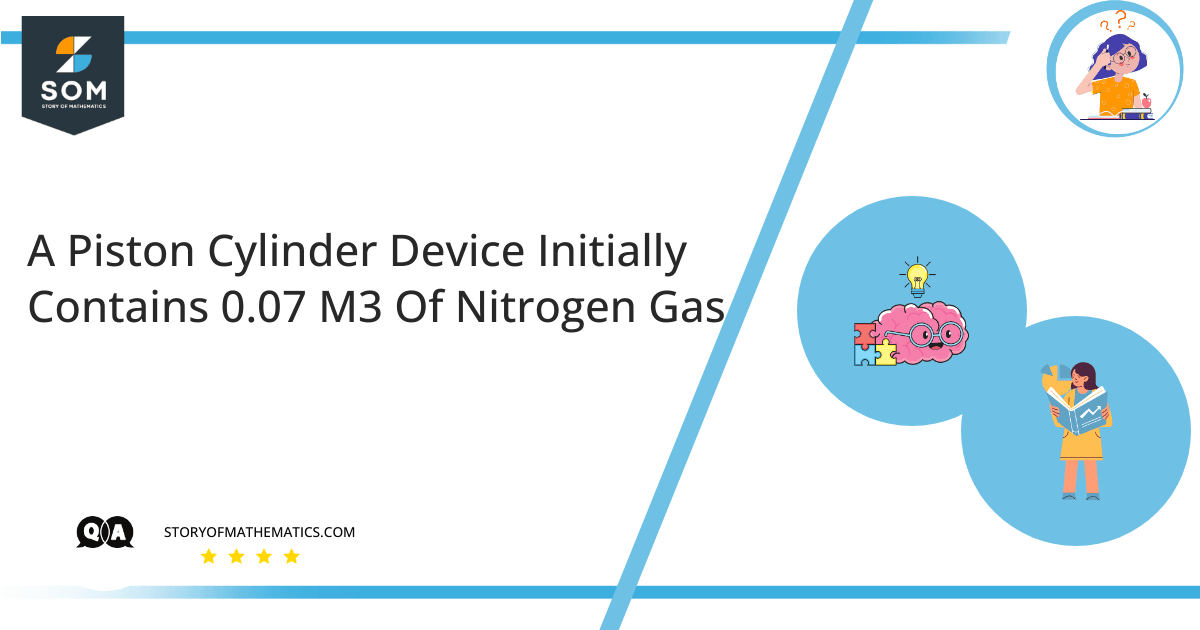
This problem aims to familiarize us with different state laws of physics and chemistry involving temperature, volume, and pressure. The concepts required to solve this problem include Boyle’s law, the ideal gas law, and work done using polytropic processes.
First, we will look at Boyle’s law, which is a practical gas law that defines how the stress of gas molecules on the walls of a cylinder manages to drop as the volume of the cylinder rises. Whereas the ideal gas law describes the visible properties of ideal gases.
Here, the phrase polytropic is used to express any reversible method. Such a process revolves around any empty or sealed system of gas or vapor. This applies to both heat and work transfer mechanisms, keeping in view that the aforementioned properties are kept constant throughout the procedure.
Expert Answer
The Formulas required for this problem are:
\[ P_1 \times V^{n}_1 = P_2 \times V^{n}_2 \]
\[ W = \dfrac{P_2 \times V_2 – P_1 \times V_1}{1-n}\]
\[ m = \dfrac{P_1 \times V_1}{R\times T_1} \]
From the statement, we are given the following information:
The initial Volume, $V_1 = 0.07 m^3$.
The initial Pressure, $P_1 = 130 kPa$.
The final Pressure, $P_2 = 80 kPa$.
Now we will find the final volume of the nitrogen gas, $V_2$ which can be obtained as:
\[ P_1 \times V^{n}_1 = P_2 \times V^{n}_2\]
\[ V_2 = \left ( \dfrac{P_1\times V^{n}_1}{P_2} \right )^ {\dfrac{1}{n}}\]
Here, $n$ is the polytropic index of nitrogen and its equal to $1.4$.
\[ V_2 = \left ( \dfrac{130kPa\times (0.07 m^3)^{1.4}}{80 kPa} \right )^ {\dfrac{1}{1.4}} \]
\[ V_2 = 0.0990 m^3 \]
Since we have obtained the final volume, we can calculate the final temperature with the formula:
\[ \dfrac{V_1}{T_1} = \dfrac{V_2}{T_2}\]
\[ T_2 = \dfrac{V_2\times T_1}{V_1} \]
\[ T_2 = \dfrac{0.0990\times (180+273)}{0.07} \]
\[ T_2 = 640 K \]
Now we can finally calculate the boundary work done for the polytropic process using the formula:
\[ W = \dfrac{P_2 \times V_2 – P_1 \times V_1}{1-n} \]
Substituting the values:
\[ W = \dfrac{80k \times 0.0990 – 130k \times 0.07}{1 – 1.4} \]
\[ W = 2.95 kJ\]
Hence, the work done.
Numerical Result
The final Temperature $T_2$ comes out to be $640 K$ whereas the boundary work done comes out to be $2.95 kJ$.
Example
A piston-cylinder machine initially contains $0.4 m^3$ of air at $100 kPa$ and $80^{ \circ}C$. The air is now isothermally condensed to $0.1 m^3$. Find the work done during this process in $kJ$.
From the statement, we are given the following information:
The initial Volume, $V_1 = 0.4 m^3$.
The initial Temperature, $T_1 = 80^{ \circ}C = 80 + 273 = 353 K$.
The initial Pressure, $P_1 = 100 kPa$.
The final Volume, $V_2 = 0.1 m^3$.
We can calculate the boundary work done using the formula:
\[ W = P_1\times V_1 \log_{e}\dfrac{V_2 }{V_1}\]
\[ W = 100\times 0.4 \log_{e}\dfrac{0.1 }{0.4}\]
\[ W = -55.45 kJ \]
Note that the negative sign shows that the work done through the system is negative.
